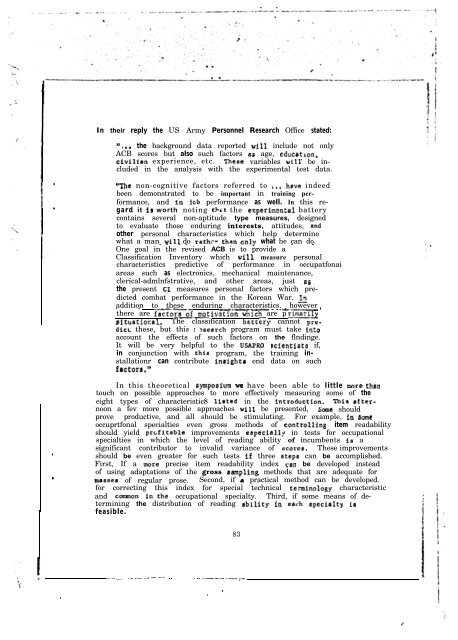Technical Report - International Military Testing Association
Technical Report - International Military Testing Association
Technical Report - International Military Testing Association
Create successful ePaper yourself
Turn your PDF publications into a flip-book with our unique Google optimized e-Paper software.
.<br />
.<br />
.<br />
In their reply the US Army Personnel Research Office stated:<br />
..* the background data reported will include not only<br />
ACB scores but also such factors as age, cducatkon,<br />
cfvilfan experience, etc. These variables wtLK be included<br />
in the analysis with the experimental test data.<br />
“The non-cognitive factors referred to *.. have indeed<br />
been demonstrated to be important in training performance,<br />
and in jcb performance as well. In this regard<br />
it Is worth noting tbct the erperinen:al battery<br />
contains several non-aptitude type measures, designed<br />
to evaluate those enduring interests, attitudes, rind<br />
other personal characteristics which help determine<br />
what a man - vi11 - - do - rathtr than cnly what he can - do. -<br />
One goal in the revised ACB is to provide a<br />
Classification Inventory which vi11 measure personal<br />
characteristics predictive of performance in occupatfonai<br />
areas such as electronics, mechanical maintenance,<br />
clerical-admlnfstrative, and other areas, just as<br />
the present CI measures personal factors which predicted<br />
combat performance in the Korean War. 2<br />
-addition - to these enduring --s--Y characteristics. - - -a__- however *<br />
there are factorof my.--_ a~otivstion which .e-are prfmnrlQ<br />
-situatfocel. - The classification br,ttery cannot predfct<br />
these, but this r Isearch program must take Lnto<br />
account the effects of such factors on the flndinge.<br />
It will be very helpful to the USAPRO scfentieta if,<br />
in conjunction with thfe program, the training installationr<br />
can contribute inrlghtr end data on such<br />
factors.”<br />
In this theoretical sympooio?n M have been able to little more thrrr<br />
touch on possible approaches to more effectively measuring some of the<br />
eight types of characteristic8 listed in the tntroduction. Thin afternoon<br />
a fev more possible approaches wfll be presented, Some should<br />
prove productive, and all should be stimulating. For example, in some<br />
occuprtfonal specialties even gross methods of controllfng item readability<br />
should yield prcfitable improvements especiallqr in tests for occupational<br />
specialties in which the level of reading ability of incumbents f~ a<br />
significant contributor to invalid variance of Hcorca. These improvements<br />
should be even greater for such tests i.f three 8teps can be accomplished.<br />
First, If a more precise item readability index can be developed instead<br />
of using adaptations of the gross sampling methods that are adequate for<br />
masfies of regular prose. Second, if a practical method can be developed.<br />
for correcting this index for special technical terminology characteristic<br />
and counon inthe occupational specialty. Third, if some means of determining<br />
the distribution of reading ability in each specfalty ia<br />
feasible.<br />
83<br />
---- .-. ..- .--_ -_8_-.-.-- ..- - ._ -.-. -..- ._ .__.(._<br />
.<br />
*<br />
k









